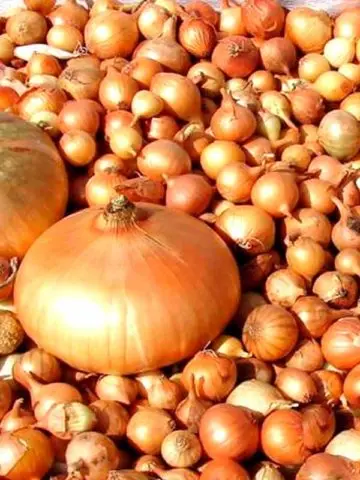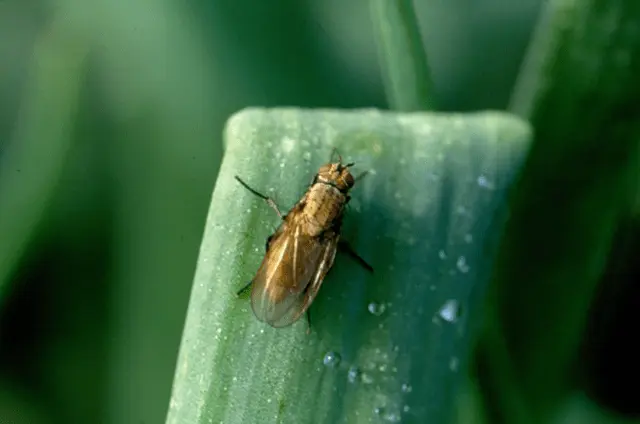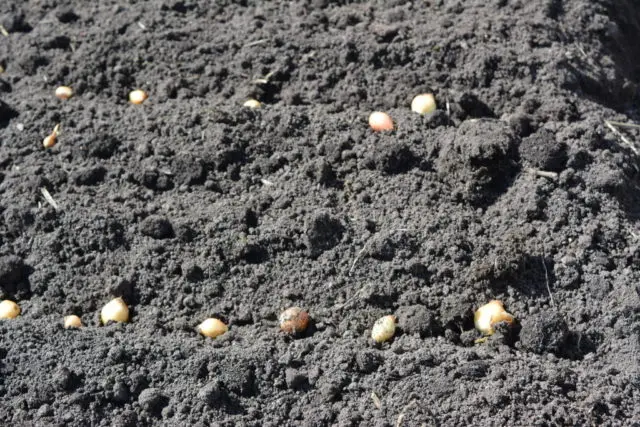Contents
Among the many varieties of onions, winter variations are popular with gardeners, as they bring the crop earlier. Onion Shakespeare has a number of advantages over many winter varieties, both in terms of care and yield.

History of variety breeding
Directly onions appeared as early as 4 thousand years BC. The homeland of this cultivated plant is China. But the Shakespeare onion is a variety of Dutch selection. In Our Country, the variety appeared quite recently, but has already gained some popularity. Breeders bred a variety that is intended exclusively for planting in the fall; when planted in the spring, the yield is much less. This variety is sown with sevkom.
Description of onions
Onion Shakespeare – winter variety, has a bulb weight of about 100 grams. Another advantage is early ripening.
The bulb is rounded, covered with round hard scales of yellow-brown color. The flesh of the fruit is white, rather juicy, and tastes semi-sharp. It is not prone to shooting, which greatly distinguishes it from other winter varieties.
Characteristics of winter onion Shakespeare
There are several main characteristics that characterize the Shakespeare winter onion and give it positive feedback. First of all, it is an early-ripening variety that yields one of the first crops among all known winter onion varieties. Bulbs have excellent taste qualities.
Productivity
With proper care and competent agricultural technology, already 70 days after the first shoots, you can harvest. Onion yield is 3.5 kg/m2 . The fruits have a dense shell that helps to endure severe frosts. This allows you to grow the onion in question even in the conditions of the Siberian winter. It tolerates frosts down to -18 °C.
Disease and pest resistance
Onions before the winter Shakespeare is great for beginner gardeners, because it is resistant to most diseases and pests. But the onion fly still infects the plant, and therefore preventive measures should be taken.

Advantages and disadvantages of the variety
The Shakespeare winter onion variety has a number of advantages for which gardeners appreciate this variety.
Grade advantages:
- sevok does not need to be stored until spring;
- ripens much earlier than sown in the spring;
- excellent taste;
- resistance to the formation of arrows;
- resistance to common onion diseases.
The only drawback of onion Shakespeare can be considered a shelf life, but this applies to all winter varieties.
Planting and caring for winter onions Shakespeare
In order to collect the maximum yield, it is necessary to follow the rules of agricultural technology. Shakespeare’s onion sets are winter because it is not recommended to plant them in the spring. It is important to meet the deadlines and properly prepare the land. The terms, first of all, depend on the climatic conditions of the region where the landing takes place.
When to plant winter onions Shakespeare
Planting time may vary from year to year depending on air and soil temperature. Usually this is the end of October and the beginning of November. If the onions are planted too early, this will lead to early shoots and subsequent freezing. With a belated planting, the onion will not have time to give roots before the onset of winter. The air temperature must be +5 °C. At the same time, approximately 0 weeks should remain until a temperature of 2 ° C. Winter onion sets of the Shakespeare variety take root and grow even in Siberia, but according to reviews, it is important to plant it a couple of weeks before frost so that it does not freeze and has time to take root.
When to plant winter onions Shakespeare in Siberia
For landing in Siberia, earlier dates are needed. Before the onset of severe frosts, at least a month should pass after planting. Therefore, in Siberia, the planting date is determined approximately in mid-October or a little earlier.
Preparation of beds
It is advisable to prepare the beds for planting in advance so as not to do this in the cold. First of all, the earth must be dug up and cleared of the remnants of previous plantings. To improve soil fertility, you can use humus, potassium salt, superphosphate. And also, wood ash is perfect to increase the nutritional value of the soil, but you should be careful with fertilizers containing nitrogen. It is also forbidden to use fresh manure.
It is advisable to choose a sunny and dry place for an onion bed. The bed is made 15–20 cm high. Furrows for planting are made at a distance of 15 cm. The bulbs must be planted to a depth of 3 cm.
How to plant Shakespeare onions before winter
Initially, the seed should be disinfected in a solution of potassium permanganate for 10 minutes. This will be the prevention of many diseases and will strengthen the seed before planting. Then dry the bulbs thoroughly and only then proceed to planting. You can plant one bulb at a time, but also for this variety, planting nests of 3-4 sets in one hole is also acceptable. If planted deeper than 3 cm, then in the spring it will be difficult for him to sprout, and if planted on the surface, the onion may freeze in winter.

Growing onions
When growing, it is important to follow the basic requirements for watering, feeding and care. Then the yield will be as high as possible. After planting, the onion must be mulched. In winter, make sure that there is enough snow on the beds. In the spring, the mulch should be removed, and then covered with a thin layer of ash on the beds.
Watering. After planting, the vegetable does not need watering. In spring, there is enough natural precipitation, and therefore the soil is already moist. The first watering is needed no earlier than in the first half of May. The characteristics of the Shakespeare onion show that it is unpretentious in care, but it is still necessary to monitor sufficient moisture.
Top dressing. The first time the soil needs to be fed at the time the bulb begins to ripen. The second top dressing – after 14 days. Potassium phosphate fertilizers are perfect for this. The best option would be to apply fertilizers in liquid form, since this way they are better absorbed.
Be sure to weed the bed so that the weeds do not interfere with the plant’s growth and development. And also be sure to loosen the soil, because the bulbs need air access.
Harvesting and storage of crops
Approximately 2,5 months after germination, you can start harvesting Shakespeare onions. The bulbs are dug up with a pitchfork. Shake off the soil from the bulb and spread the crop in the open air. Then the crop is transferred under a canopy to dry completely until the necks of the bulbs dry out. At this point, you need to cut off the roots and the remains of the stem.
If you put the crop in a cool place, it can last up to six months. The room must be absolutely dry and without signs of mold on the walls. High humidity will not allow the crop to survive.

Ways to propagate onions
The main propagation method for the Shakespeare variety is the use of sets. Seeds can be of various sizes, depending on the purpose of cultivation. Very small bulbs up to 1 cm are used to obtain a crop with the longest shelf life. If you use a set with a larger diameter, then it is possible to get a good feather for spring use.
Diseases and pests, methods of control and prevention
The most common pest is the onion fly. To combat it, marigolds can be planted around the beds, which will scare away the pest. When the first signs of any disease appear, it is necessary to treat the plant with fungicides. And also useful treatment with copper chloride. In a more severe case, systemic fungicides will do.
Conclusion
Onion Shakespeare is a winter variety of Dutch selection. It is also grown on the territory of Our Country, due to its frost resistance. Unpretentious in care and resistant to many diseases. Has excellent taste. When planting, it is important to observe the deadlines and be in time before frost so that the seedlings take root. Winter onion Shakespeare is also suitable for growing in Siberia with proper care.









